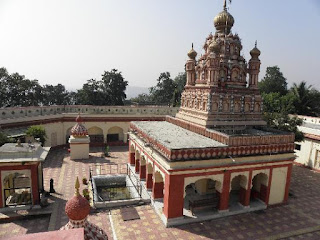The Kamakhya Temple is a Hindu temple dedicated to the mother goddess Kamakhya. It is one of the oldest of the 51 Shakti Pithas. Situated on the Nilachal Hill in western part of Guwahati city in Assam,India, it is the main temple in a complex of individual temples dedicated to the ten Mahavidyas: Kali, Tara, Sodashi, Bhuvaneshwari,Bhairavi, Chhinnamasta, Dhumavati, Bagalamukhi, Matangi and Kamala. Among these, Tripurasundari, Matangi and Kamala reside inside the main temple whereas the other seven reside in individual temples. It is an important pilgrimage destination for general Hindu and especially for Tantric worshipers.
The templehas been built and renovated many times in the period 8th-17th century, gave rise to a hybrid indigenous style that is sometimes called the Nilachal type: . The inner sanctum, the garbhagriha, is below ground level and consists of no image but a rock fissure in the shape of a yoni:The garbhagriha is small, dark and reached by narrow steep stone steps. Inside the cave there is a sheet of stone that slopes downwards from both sides meeting in a yoni-like depression some 10 inches deep. This hollow is constantly filled with water from an underground perennial spring. It is the vulva-shaped depression that is worshiped as the goddess Kamakhya herself and considered as most important pitha (abode) of the Devi.
The templehas been built and renovated many times in the period 8th-17th century, gave rise to a hybrid indigenous style that is sometimes called the Nilachal type: . The inner sanctum, the garbhagriha, is below ground level and consists of no image but a rock fissure in the shape of a yoni:The garbhagriha is small, dark and reached by narrow steep stone steps. Inside the cave there is a sheet of stone that slopes downwards from both sides meeting in a yoni-like depression some 10 inches deep. This hollow is constantly filled with water from an underground perennial spring. It is the vulva-shaped depression that is worshiped as the goddess Kamakhya herself and considered as most important pitha (abode) of the Devi.

































